The traditional, full English breakfast is no trivial matter. It is an incredibly filling 4- to 5-course meal. On a normal day, given a typical person, each of the courses could be a breakfast by itself. Combined, the amount of food is enough to choke a mule! It is hard to imagine that in the Victorian times this would be a meal for one.
Compared to France or Italy where a breakfast consists of a piece of pasty and some type of coffee (black, with milk or cappuccino), English breakfast is incredibly huge. It consists of a starter (fruit juice, prunes, grapefruit), cereal, a main course, toast and marmalade and, of course, tea.
It would be silly to imply that everybody in the U.K. eats like this every morning. This is based on readings about 19th century traditions, which we found interesting.
English breakfast has very close cousins in Scotland, Ireland and Wales.
Thanks to our friend Jake Shaw for his comments and contributions.
 |
The first course is a glass of orange juice or half a grapefruit cut into segments, sprinkled with sugar and eaten with a spoon. Tea and coffee with milk are served. Orange juice is said to be a very recent addition brought over by American soldiers during WWII. |
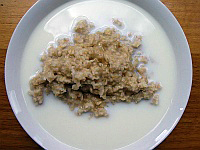 |
The second course is porridge with milk... |
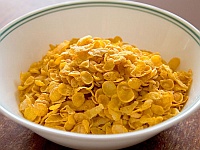 |
... or cornflakes (for those who hate oatmeal). |
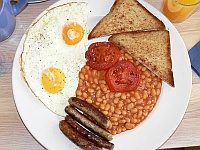 |
The third course is the main event: the essence is bacon and eggs (over easy or sunny-side up) and sausage. A second tier can consist of tomatoes (grilled or canned plum variety), black pudding from Lancashire (a type of Blutwurst), mushrooms, fried potatoes and bread. This is traditionally fried in the fat from the bacon and sausages. A third tier can include kidneys, sweetbreads, hogs pudding, potato cakes, and even have french fries. Baked beans is also a relatively recent addition introduced by American soldiers during WWII. |
 |
The fourth course is a choice between fish or meat: kipper (salted, pickled and smoked herring), deviled kidneys (spicy lamb kidneys cooked in a mixture of Worcestershire sauce, mushroom, ketchup, English mustard powder, butter, cayenne pepper, salt, and black pepper) or kedgeree (cooked fish in curried rice). |
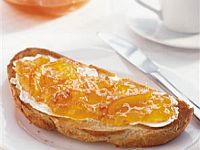 |
For the fifth and final course, toast, marmalade and jam are served, just in case you are not bursting yet. |
 |
A note on the proper methodology of making English tea: fresh boiling
water is poured directly onto the leaves or bag, then left to stand for 3 minutes.
Note that this holds for black tea. As a sidenote, other teas i.e. green use hot
but not quite boiling water - makes them taste bitter. White tea uses water 65-70
°C (149-158 F), Yellow tea uses 70-75 °C (158-167 F), Green tea 75-80 °C (167-176 F)
Oolong tea 80-85 °C (176-185 F). But since English breakfast tea is black a blend
of black teas, hot water it is! English breakfast tea is full-bodied, robust, and rich, blended to go well with milk and sugar. The origin of the ingredients reflects the history of the British empire: Assam (India), Ceylon (Sri Lanka), and Kenya. Drinking a blend of black teas for breakfast is indeed a longstanding British custom. However, the name "English Breakfast Tea" appears to have originated in colonial America. The first such blend to be commercialized in America dates to 1843 and a tea merchant named Richard Davies in New York City. |
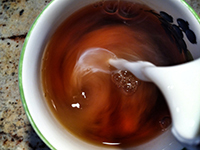 |
English breakfast tea is usually served with milk. There is a ongoing debate whether the milk goes in first or not. If the milk goes in first, it saves the china from potential cracking and scolds the milk (important in the old days before pasteurisation). Or, the tea is poured and the guests are allowed to "milk" the tea to their desires. |
back to Radim and Lisa's Well-Travelled Cookbook | email us
Last updated: October 4, 2015
Some photographs from Wikimedia Commons
used under the terms of the GNU Free Documentation License.